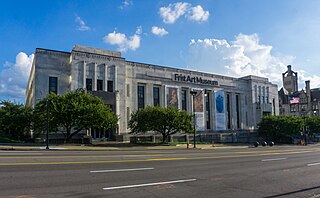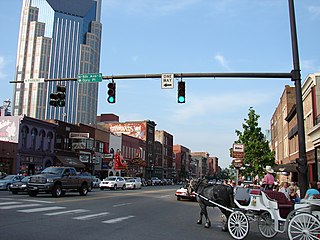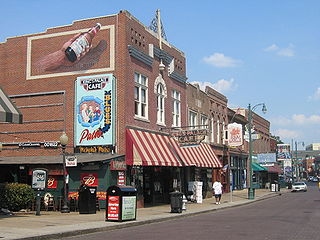
Chester Burton Atkins, also known as "Mr. Guitar" and "The Country Gentleman", was an American musician who, along with Owen Bradley and Bob Ferguson, helped create the Nashville sound, the country music style which expanded its appeal to adult pop music fans. He was primarily a guitarist, but he also played the mandolin, fiddle, banjo, and ukulele, and occasionally sang.
The Nashville Sound originated during the mid-1950s as a subgenre of American country music, replacing the chart dominance of the rough honky tonk music, which was most popular in the 1940s and 1950s, with "smooth strings and choruses", "sophisticated background vocals" and "smooth tempos" associated with traditional pop. It was an attempt "to revive country sales, which had been devastated by the rise of rock 'n' roll".

The Museum of History & Industry (MOHAI) is a history museum in the South Lake Union neighborhood of Seattle, Washington, United States. It is the largest private heritage organization in Washington state, maintaining a collection of nearly four million artifacts, photographs, and archival materials primarily focusing on Seattle and the greater Puget Sound region. A portion of this collection is on display in the museum's galleries at the historic Naval Reserve Armory in Lake Union Park.

The Frist Art Museum, formerly known as the Frist Center for the Visual Arts, is an art exhibition hall in Nashville, Tennessee, housed in the city's historic U.S. Post Office building, which is listed on the National Register of Historic Places.
Stephen Henry Sholes was a prominent American recording executive with RCA Victor.

Floyd Cramer was an American pianist who became famous for his use of melodic "whole-step" attacks. He was inducted into both the Country Music Hall of Fame and the Rock and Roll Hall of Fame. His signature playing style was a cornerstone of the pop-oriented "Nashville sound" of the 1950s and 1960s. Cramer's "slip-note" or "bent-note" style, in which a passing note slides almost instantly into or away from a chordal note, influenced a generation of pianists. His sound became popular to the degree that he stepped out of his role as a sideman and began touring as a solo act. In 1960, his piano instrumental solo, "Last Date" went to number two on the Billboard Hot 100 pop music chart and sold over one million copies. Its follow-up, "On the Rebound", topped the UK Singles Chart in 1961. As a studio musician, he became one of a cadre of elite players dubbed the Nashville A-Team and he performed on scores of hit records.

Music Row is a historic district located southwest of downtown Nashville, Tennessee, United States. Widely considered the heart of Nashville's entertainment industry, Music Row has also become a metonymous nickname for the music industry as a whole, particularly in country music, gospel music, and contemporary Christian music.

RCA Studio B was a music recording studio built in 1956 in Nashville, Tennessee by RCA Victor. Originally known simply as "RCA Studios," Studio B, along with the larger and later RCA Studio A became known in the 1960s for being an essential factor to the development of the musical production style and sound engineering technique known as the Nashville Sound. In the two decades the studio was in operation, RCA Studio B produced 60 percent of the Billboard magazine's Country chart hits. The studio closed in 1977.
William Owen Bradley was an American musician, bandleader and record producer who, along with Chet Atkins, Bob Ferguson, Bill Porter, and Don Law, was a chief architect of the 1950s and 60s Nashville sound in country music and rockabilly.

The Tennessee State Museum is a large museum in Nashville depicting the history of the U.S. state of Tennessee. The current facility opened on October 4, 2018, at the corner of Rosa Parks Boulevard and Jefferson Street at the foot of Capitol Hill by the Bicentennial Capitol Mall State Park. The 137,000-square-foot building includes a Tennessee Time Tunnel chronicling the state's history by leading visitors though the museum's permanent collection, a hands-on children's gallery, six rotating galleries, a digital learning center, and a two-story Grand Hall. Exhibitions include significant artifacts related to the state's history, along with displays of art, furniture, textiles, and photographs produced by Tennesseans. The museum's Civil War holdings consists of uniforms, battle flags, and weapons. There is no admission charge for visitors.

Broadway is a major thoroughfare in the downtown area in Nashville, Tennessee. It includes Lower Broadway, an entertainment district renowned for honky tonks and live country music.

Tourism in Memphis includes the points of interest in Memphis, Tennessee such as museums, fine art galleries, and parks, as well as Graceland the Beale Street entertainment district, and sporting events.
The Grammy Museum is any of a group of museums containing exhibits relating to winners of the Grammy Award for achievement in recording.

The Grammy Museum is an interactive, educational museum devoted to the history and winners of the Grammy Awards. The Museum has interactive touch-screens, videos, recording booths, and a collection of historical music artifacts including costumes and instruments from the Grammy Awards, hand-written lyrics, records, and audio/video recordings.
The Country Music Foundation (CMF) chartered by the state of Tennessee in 1964, is a non-profit organization dedicated to the preservation and education surrounding country music. The CMF currently employs more than 70 full-time professionals and is "the world's largest research center devoted to a single form of popular music."

The Musicians Hall of Fame and Museum (MHOF) in Nashville honors all musicians regardless of genre or instrument. The MHOF timeline starts with the beginning of recorded music and inductees are nominated by current members of the American Federation of Musicians and by other music industry professionals.

The Johnny Cash Museum opened in May 2013 in Nashville, Tennessee, to honor the life and music of the country superstar often referred to as the "Man in Black." It houses the world's largest collection of Johnny Cash memorabilia and artifacts, including a stone wall taken from his lake house in Hendersonville, Tennessee, and is officially authorized by Cash's estate.

The Patsy Cline Museum is a museum that opened on April 7, 2017 on the second floor of the Johnny Cash Museum building on Third Avenue South in Nashville, Tennessee. It is home to an extensive collection of Patsy Cline memorabilia as well as real-life artifacts once owned by the country singer, who died in a plane crash in 1963 at the age of 30.
Jerry Owen Bradley was an American music executive known for his role in country music. As head of RCA Records in Nashville from 1973 to 1982, Bradley was involved in the marketing and creation of the first platinum album in country music, Wanted! The Outlaws, which reached that mark in 1976. Bradley was inducted in the Country Music Hall of Fame in 2019.
Hubert Long was an American music executive known for his promotion of country music artists from the early 1950s to his death in 1972. Long created a talent agency named for him in 1952 and one of Nashville's first independent talent agencies, Stable of Stars, three years later. A founding board member of the Country Music Association (CMA) and the Country Music Foundation (CMF), Long was posthumously inducted into the Country Music Hall of Fame in 1979.


















